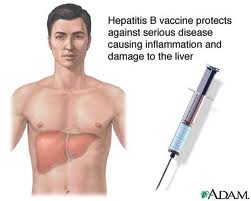By: Ira Hope, RN
Hepatitis B is a viral infection that targets the liver and causes both acute and chronic disease.According to the World Health Organization, about 2 billion people worldwide have been infected with the virus and about 350 million live with chronic infection. About 600,000 people die annually due to Hepatitis B infection. 25% of the people infected with this type of hepatitis will probably have liver cirrhosis when they age.
When compared to HIV, this is 50 times more prevalent and a occupational health hazard for medical personnel. A vaccine specific to this type of virus is readily available for optimum protection.
Common modes of transmission:
- perinatal (from mother to baby at birth)
- early childhood infections (inapparent infection through close interpersonal contact with infected household contacts)
- unsafe injections practices
- blood transfusions
- sexual contact
Cause:
Contact with blood or body fluids with persons with Hepatitis B.
This is not transmitted with casual contact with infected persons.
Signs and Symptoms:
- yellowing of the skin and eyes (jaundice)
- dark urine
- extreme fatigue
- nausea
- vomiting
- abdominal pain
Complications:
- Liver Cancer
- Liver Cirrhosis
Medical Management:
- Management of pain and other associated symptoms.
- Adequate nutritional balance, including replacement of fluids that are lost from vomiting and diarrhea are implemented too.
- Chronic hepatitis B can be treated with interferon and anti-viral agents.
Nursing Management:
- Educate would-be parents that infants should have the hepatitis B vaccine. this is the mainstay of hepatitis B prevention.
- Inform that the certain protection may last for almost 20 years, updates of screening must be done.
- For blood donors, proper screening must be done in order to be sure that the blood being donated is Hepatitis B virus free.
- Assist in administration of Hepatitis B immuno globulin.
- Teach clients proper handling of blood and body fluids as well as practice of correct hand washing.
- Encourage clients to use yellow-colored garbage bag as a sign of infectious waste which is universally recognized.
- For persons diagnosed to be positive with Hepatitis B, assist in feeding them with small frequent meals containing high-calorie, low-fat diet.
- Listen to the family and the client as to any concerns about the alterations in the daily living due to the disease process.
Photo credits: www.nlm.nih.gov










Nice! Great.. keep posting..
What is the significance of a low fat diet specifically with Hep B?
Tiffany Lee Cornell the affected organ is the liver so you need to avoid fats.
The liver.
if someone is positive with this,can they still study nursing and work as a nurse after studies?
The liver stores bile,bile emulsifies fat digestion.
fat can not be digested if the liver is damage coz the liver produces bile to digest the fats so the diet must be on low fat and also low in (chon)protien.
The gallbladder produces the bile and the liver only store it thru the bile ducts.
will preval the deep optitions about the virus,the disease and signs and symptoms and etc.
Tiffany Lee Cornell. The liver is the one emulsifies the fats. And It happens that hep.B affects the liver.
Supportive care:
– encourage the pt. To eat meals in a sitting position to reduce pressure on the liver.
– encourage pleasing meals in an environment with minimal noxious stimuli (odors, noise, interruptions).
– administer or teach self-administration of antiemetics as prescribe. Avoid phenothiazines such as chlorpromazine, which have colestatic effect and may cause or women jaundice.
– encourage frequent oral fluids
– encourage rest during symptomatic phase
Uh oh I hope there is not bad news out there!
Symptoms-jaundice are the most common symptom of hep-b(the skin nd white of eyes appear yellow)
Tiredness
Mild fever
Loss of appetite,nausea nd vomiting
Constant discomfort on the right side of abdomen under the rib cage,where liver is located
Diarrhoea
Constipation
Muscle ache or joint pain
Skin rashes
Vast majority of people recover, some don’t even realize they have it. Vaccine companies never tell you that
Wheng Armeña, it’s the other way around: liver produces bile. Gallbladder stores it.
@ Wheng armeña Bile or gall.produced by the liver and stored in gallbladder.. Kaya nga gallbladder… So storage sia ng gall..
Samantha Spallone like this page! keeps you reminded of things! don’t worry, there will be more haha
Paano po gamutin help me po tanx po
Is there any cure of having hepa b??